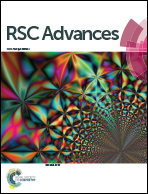An experimental and theoretical approach on the kinetics and mechanism for the formation of a four-membered (S, S) chelated Pt(ii) complex†
Abstract
The interaction of a chemoprotective agent, diethyldithiocarbamate (DDTC), with cis-[Pt(pic)(H2O)2]2+, 2 (where pic = 2-aminomethylpyridine), in aqueous medium was investigated experimentally and theoretically. The equilibrium constant (KE) for the formation of the outer sphere association complex and the rate constants for both steps have been evaluated experimentally, and were compared with the theoretically determined values. The activation parameters (ΔHǂ, ΔSǂ and ΔGǂ) for both the steps were calculated and an associative mechanism is proposed. The bonding modes of the product [Pt(pic)(DDTC)]+, 3, were confirmed by spectroscopic measurements and supported by Time Dependent Density Functional Theory (TD-DFT) and Natural Bond Orbital (NBO) calculations. Penta coordinated platinum transition state geometries for both the steps were fully optimized and confirmed by frequency analysis and an intrinsic reaction coordinate method molecular docking study has been performed to understand the binding interaction of complex 2 with B-DNA. The anticancer properties of 2 and 3 were investigated on a HeLa cell line, and they showed remarkable activity of about 70% compared to cisplatin at 50 μM concentration.


 Please wait while we load your content...
Please wait while we load your content...